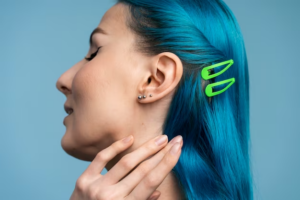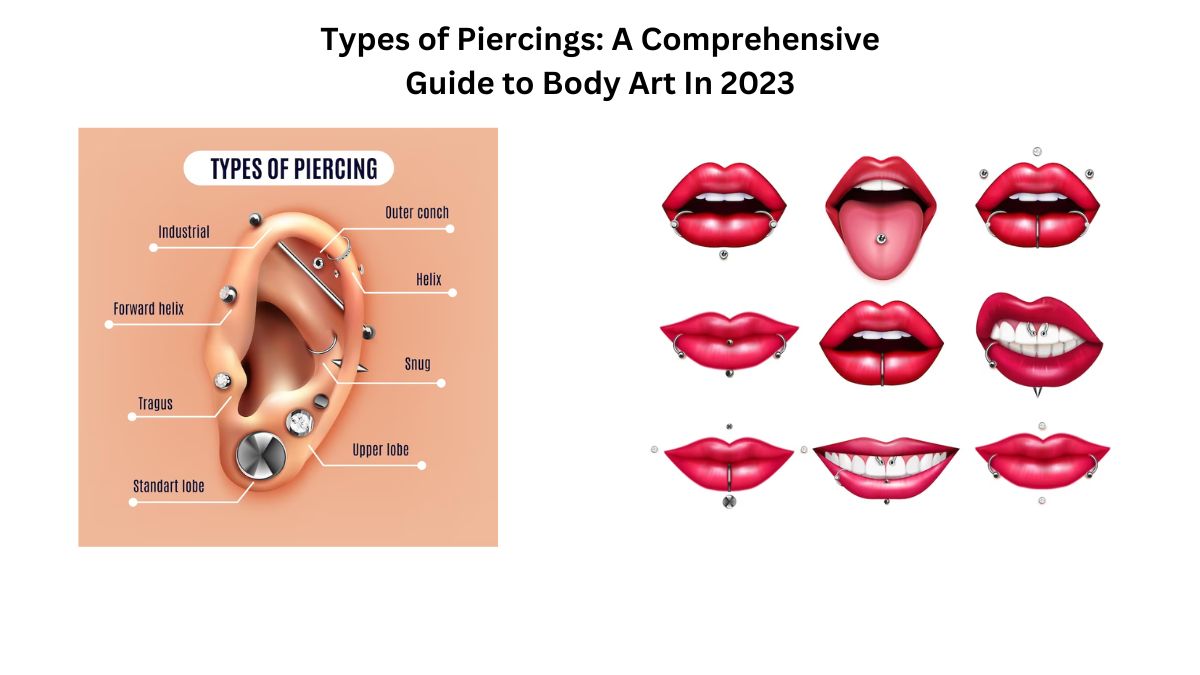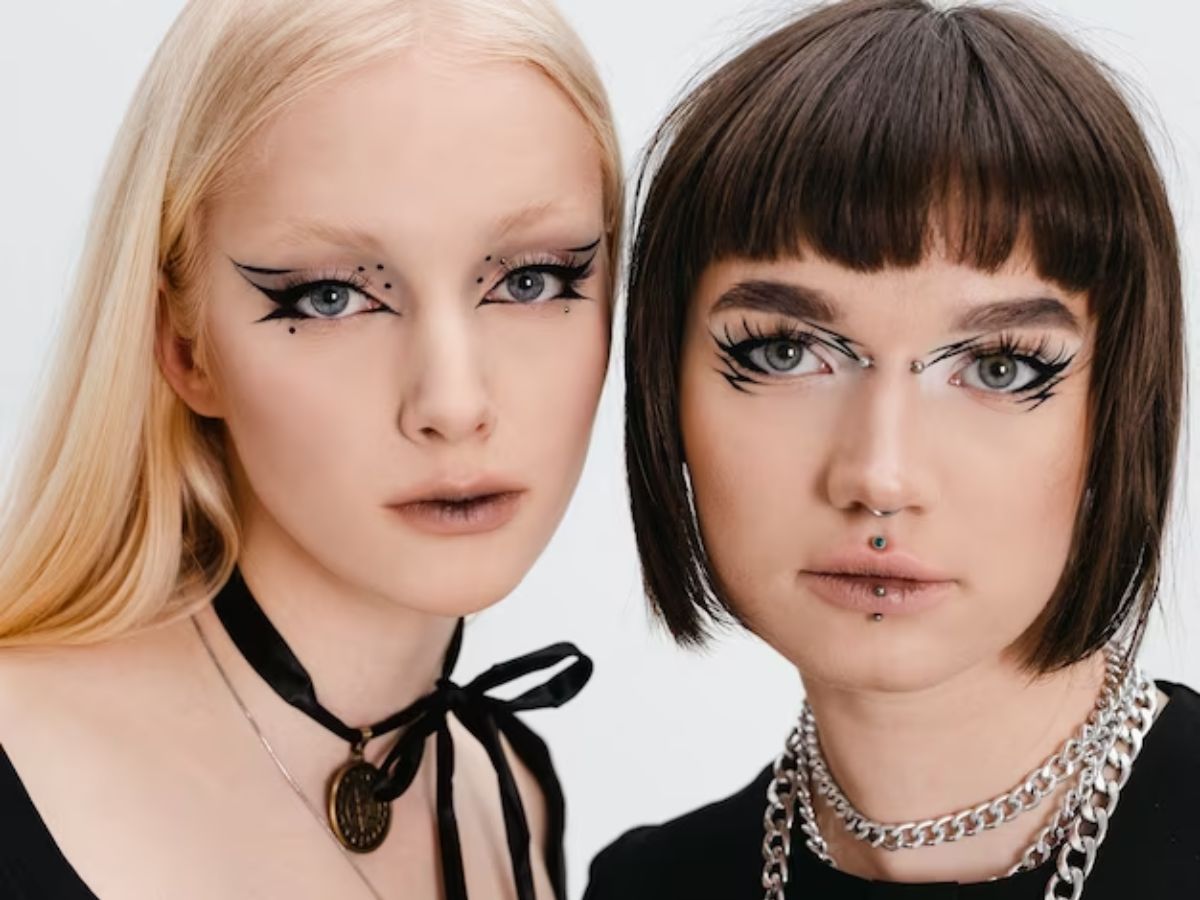Piercings have been a popular form of body art for centuries, and they continue to captivate individuals seeking unique expressions of their individuality. From simple earlobe piercings to more daring body modifications, there’s a vast array of piercing options available today. In this blog, we’ll explore the various types of piercings, their origins, the piercing process, aftercare, and some interesting facts surrounding this ancient practice.
1. Ear Piercings:

- Earlobe Piercing: The most common type, done on the fleshy lower part of the earlobe.
- Helix Piercing: Positioned along the outer rim of the upper ear.
- Tragus Piercing: Located in the small, protruding cartilage near the ear canal.
- Daith Piercing: Placed through the innermost fold of cartilage above the ear canal.
- Industrial Piercing: A barbell connecting two piercings on the upper ear.
2. Facial Piercings:

- Nose Piercing: Placed through the nostril or septum.
- Eyebrow Piercing: Positioned on the eyebrow ridge.
- Lip Piercing: Placed on the upper, lower, or both lips.
- Labret Piercing: Centered below the lower lip.
- Monroe/Madonna Piercing: Located above the upper lip on either side.
3. Oral Piercings:

- Tongue Piercing: Placed through the center of the tongue.
- Smiley Piercing: Hidden inside the upper lip, visible only when smiling.
- Frenulum Piercing: Located on the frenulum beneath the tongue.
4. Body Piercings:

- Navel Piercing: Placed through the navel (belly button).
- Nipple Piercing: Positioned through the nipple area.
- Surface Piercing: Placed on flat areas of the body, like the collarbone or hip bone.
5. Genital Piercings:

- Male: Prince Albert, Apadravya, Frenum, Guiche, Hafada, etc.
- Female: Clitoral Hood, Vertical Clitoral Hood, Triangle, Christina, etc.
The Piercing Process:
Piercings should always be performed by a professional piercer in a clean and sterile environment. The process involves marking the piercing site, using a sterilized needle to create the hole, and then inserting the chosen jewelry.
Aftercare:
Proper aftercare is crucial to prevent infections and promote healing. Cleaning with saline solution and avoiding touching the piercing with unwashed hands are essential practices during the healing period.
Interesting Facts:
- Ancient civilizations, including the Egyptians and Romans, practiced body piercings for cultural and spiritual purposes.
- Sailors once believed that earlobe piercings could improve their eyesight and enhance their long-distance vision.
- Body piercing gained popularity in the West during the 1970s and has since become a significant aspect of contemporary fashion and self-expression.
Body piercings have a rich history and continue to be a popular form of self-expression and artistry. Whether you opt for a subtle earlobe piercing or a more adventurous genital piercing, each type of piercing holds its unique appeal. Remember, safety and hygiene are paramount when getting a piercing, so always seek professional expertise and follow proper aftercare to ensure a successful and stunning result.
Pros and Cons Of Different Types Of Piercings
PROS
Piercings offer numerous benefits, and the pros can vary depending on individual preferences and the type of piercing. Here are some common advantages of different types of piercings:
- Self-expression: Piercings provide a unique and creative way to express one’s individuality and style. They can be a form of art that reflects your personality, culture, or interests.
- Versatility: With a wide array of piercing options, you can choose from various placements and jewelry styles, allowing you to change your look whenever you like.
- Minimal permanence: Unlike tattoos, piercings are generally reversible. If you decide you no longer want a specific piercing, you can remove it, and in most cases, the hole will close over time.
- Social acceptance: In many cultures, piercings have become widely accepted and are considered a fashionable accessory. This acceptance can help people feel more comfortable and confident with their piercings.
- Boosted confidence: For some individuals, piercings can be empowering and boost self-confidence. Having a piercing that you love and feel proud of can positively impact self-esteem.
- Ritual and cultural significance: In some cultures, piercings hold spiritual or cultural significance, and getting a piercing can be a rite of passage or a way to connect with one’s heritage.
- Sensory pleasure: Certain piercings, such as nipple or genital piercings, can enhance sensitivity and provide added pleasure during intimate experiences for some individuals.
- Potential health benefits: Some claim that certain ear or body piercings can offer acupuncture-like benefits by stimulating specific pressure points on the body, potentially providing relief for certain ailments.
- Enhanced appearance: Piercings can draw attention to and accentuate particular features, such as facial piercings highlighting cheekbones or nose shape.
- Networking and community: The piercing community can be a supportive and inclusive space. Many people bond over their shared passion for body modification and exchange tips, experiences, and jewelry recommendations.
It’s important to note that while there are many advantages to piercings, they do come with some risks and responsibilities. Proper aftercare and choosing a reputable, experienced piercer are crucial to ensure a safe and successful piercing experience. Always weigh the pros and cons and make informed decisions that align with your lifestyle and values.
CONS
While piercings can be a form of self-expression and bring many benefits, they also come with certain drawbacks and potential risks. Here are some common cons of different types of piercings:
- Pain and discomfort: The piercing process can be painful, and some piercings may take longer to heal, causing discomfort during the healing period.
- Infection risk: If proper aftercare is not followed, piercings can become infected, leading to redness, swelling, and discharge. In severe cases, infections may require medical attention and removal of the piercing.
- Allergic reactions: Some people may be sensitive or allergic to certain metals used in jewelry, such as nickel, leading to skin irritation or allergic reactions.
- Scarring: In some cases, piercings may leave behind scars after removal, especially if they were not properly cared for during the healing process.
- Employment restrictions: Certain professions or workplaces may have strict policies against visible piercings, which could limit job opportunities or require piercings to be hidden while at work.
- Healing time and process: Different piercings have varying healing times, and during this period, the piercing may be sensitive, limiting certain activities or requiring adjustments to daily routines.
- Rejection and migration: In some cases, the body may reject the piercing, causing it to move or migrate from its original placement, leading to dissatisfaction or potential complications.
- Damage to teeth and gums: Oral piercings, such as tongue or lip piercings, can damage teeth and gums over time, especially if the jewelry consistently rubs against them.
- Impact on relationships: Some individuals may have personal or cultural preferences against piercings, leading to potential tensions or conflicts in personal relationships.
- Cost and maintenance: Quality piercings and proper aftercare products can be costly. Additionally, some piercings may require regular maintenance, such as changing jewelry or tightening threaded ends.
- Bloodborne pathogen transmission: If proper sterilization procedures are not followed, there is a risk of bloodborne infections such as hepatitis or HIV.
It’s essential to consider these potential drawbacks and risks before getting a piercing. Doing thorough research, choosing a reputable and experienced piercer, and following proper aftercare guidelines can help minimize these cons and increase the likelihood of a successful and enjoyable piercing experience. Always make informed decisions and prioritize your health and well-being.
Also read more about Polarized Sunglasses
Conclusion for Types of Piercings
In conclusion, piercings come in a wide variety of styles, ranging from traditional earlobe piercings to more unique and uncommon piercings like corset piercings or vampire bites. They can be found on different parts of the body, including the face, ear, and various areas on the body. While piercings can be a stylish and personal form of self-expression, it’s important to take proper care during the healing process to minimize the risk of infection and ensure successful healing.
If you decide to get a piercing, make sure to seek the services of a professional piercer who follows strict hygiene standards and provides appropriate aftercare instructions. Healing times vary depending on the type of piercing, and it’s crucial to be patient and allow the piercing to heal fully before changing jewelry or removing it if desired.
Remember, the information provided here is a general overview, and for personalized advice and guidance, always consult a professional piercer. Piercings can be a beautiful addition to one’s style when done responsibly and with care.
FAQ section about Types of Piercings
Q: What are the different types of ear piercings?
A: Ear piercings come in various styles, including standard lobe piercings, helix piercings, tragus piercings, conch piercings, daith piercings, rook piercings, and industrial piercings.
Q: What are facial piercings?
A: Facial piercings refer to any piercings on the face, such as nose piercings, septum piercings, eyebrow piercings, lip piercings, cheek piercings, and philtrum piercings.
Q: What is a body piercing?
A: A body piercing generally includes any piercing that’s not on the face or earlobes. This can include nipple piercings, navel piercings, surface piercings, genital piercings, and dermal piercings.
Q: Are there any unique or uncommon piercings?
A: Yes, there are numerous unique and uncommon piercings, such as the corset piercing (a series of piercings laced together like a corset), vampire bites (dual surface piercings on the neck), and orbital piercings (a ring connecting two ear cartilage piercings).
Q: Which piercings are more prone to infection?
A: All piercings carry some risk of infection if not properly cared for, but piercings with longer healing times or those in areas with higher bacteria exposure, like mouth piercings or surface piercings, can be more prone to infection.
Q: How long does it take for piercings to heal?
A: Healing times vary depending on the type of piercing and individual healing rates. On average, earlobe piercings take 6-8 weeks, while cartilage piercings can take 6 months to a year. Facial and body piercings may take 6 weeks to 6 months or more.
Q: What materials are used for piercings?
A: Common jewelry materials for piercings include surgical steel, titanium, gold, and niobium. Avoid using low-quality metals like nickel, as they can cause allergic reactions.
Q: Can I change my jewelry during the healing process?
A: It’s generally recommended to wait until the piercing is fully healed before changing jewelry. Changing it too early can disrupt the healing process and increase the risk of infection.
Q: How can I care for my new piercing?
A: Follow the aftercare instructions provided by your piercer, which typically involve cleaning the piercing with saline solution or mild soap, avoiding touching the piercing with dirty hands, and avoiding submerging it in bodies of water like pools or lakes during the healing process.
Q: Can I remove a piercing if I change my mind?
A: Yes, you can remove a piercing if you no longer want it. However, some piercings may close up quickly, so keep in mind that re-piercing may require starting the healing process over.







































